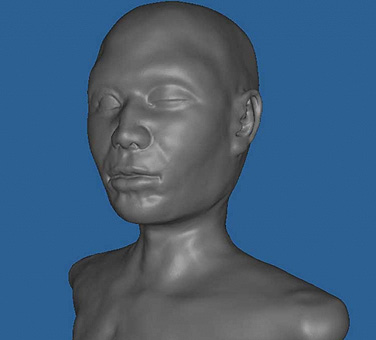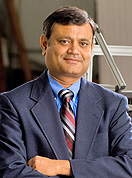News
Software assists virtual design

This bust was produced using Protean, the 3-D virtual clay sculpting software package that was developed from research initially conducted by UB mechanical engineers.
A 3-D virtual clay-sculpting software package that came on the market last week was developed from research conducted by UB mechanical engineers who wanted to speed up computational design of complex, organic shapes.
The software, called Protean, will provide industrial engineers, artists, animators, industrial designers, bioengineers and others with the ability to rapidly develop virtual representations of their designs at the earliest stages.
Tactus Technologies, a UB technology spinoff company, was started by the researchers who developed some of the technologies underlying Protean.
“Our whole focus was to jumpstart the design process for very complex, organic shapes; that is, shapes found in nature, like the human face and body,” explains Thenkurussi “Kesh” Kesavadas, director of the UB Virtual Reality Lab and professor of mechanical and aerospace engineering, School of Engineering and Applied Sciences. Kesavadas is a Tactus co-founder.
“Protean is an enormous technological advancement because it allows real-time, 3-D volumetric modeling without requiring a lot of computing power,” says Kevin P. Chugh, president and chief scientist at Tactus, who earned his doctorate at UB. “No one solves complex mathematical challenges the way our system does.”
Whereas other modeling software packages take many steps to design a human head, for example, Protean does it in fewer steps and in a far more intuitive manner, its creators say.
A unique property of the Protean software is that each design the user develops can then be added to the palette of tools available so that designs themselves become tools.
“These tools can then become the building block of a new model or can be used to squeeze, shape or smooth leading, to create even more complex shapes,” says Kesavadas.
Users also can manipulate an image to create or emboss a 3-D texture on the surface of a sculpted object.
Protean software can be combined with Falcon, a haptic device from Novint Technologies Inc., to record and transfer the amount of force exerted by the user’s hand to the virtual object, instead of clicking on selected points on the virtual object and inputting data to make the change.
“It’s a far more intuitive technology than click-and-drag virtual prototyping,” Kesavadas says. “The most natural tool for a designer is his or her hand.”
Kesavadas notes that while most virtual reality research being done at universities is based in departments of computer science, his UB lab has an advantage because it is in the Department of Mechanical and Aerospace Engineering.
“As mechanical engineers, we build both software and hardware,” he says. “UB’s Virtual Reality Lab is one of just a handful of research centers in the U.S. focused on design and manufacturing applications of virtual reality.”
Kesavadas and researchers from the UB Virtual Reality Lab are leaders in the development of haptic technologies that bring a sense of touch to virtual reality. They are developing advanced VR applications for medical, surgical and educational applications.
Click here for additional information on the Protean software.


Reader Comments